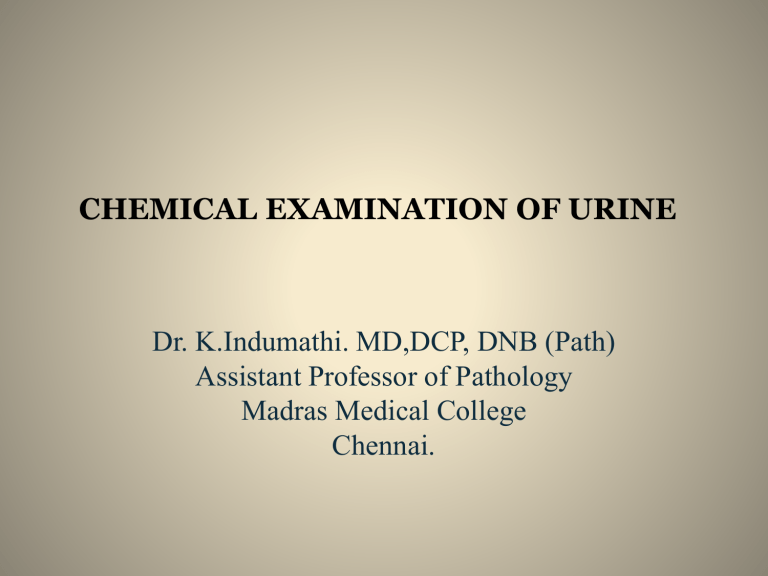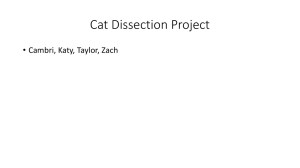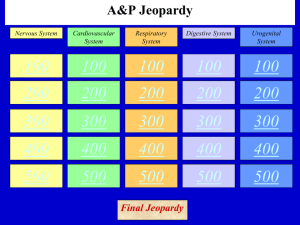
CHEMICAL EXAMINATION OF URINE Dr. K.Indumathi. MD,DCP, DNB (Path) Assistant Professor of Pathology Madras Medical College Chennai. The routine urinalysis includes chemical testing for (1) Protein (2) Glucose (3) Ketone bodies (4) Occult blood (5) Bile pigments (6) Bile salts and (7) Urobilinogen. PRESERVATIVES • Urine should be examined within 2 hrs. • If there is delay specimen should be refrigerated. • For 24 hrs urine sample (or) transport - one of the following preservative should be added- to prevent decomposition and growth of contaminating organisms. Toluene, Boric acid, Concentrated HCL, Formalin, Thymol For urobilinogn- 2.5ml of sodium carbonate placed. Requirements: Glassware : – – – – – – – • • • • • • Centrifuge tubes, Pasteur pipettes, test tubes (10x75, 15x125 and 20x150mm), Beakers (250 or 500 ml), Graduated pipettes (5 ml) and Test tube racks Reagents and chemicals required for chemical examination of urine. Benedict’s qualitative reagent Sulfosalicylic acid, Glacial acetic acid Rotheras test Fouchet’s reagent Ehrlich reagent Sulfur powder : Sugar Determination : Protein Determination : Ketone estimation : Bile pigment Determination : Determination of urobilinogen : Bile salts detection DETERMINATION OF PROTEIN General consideration: In the normal kidney only a small amount of low molecular weight protein is filtered at the glomerulus. Glomerular membrane prevents the passage of high molecular weight proteins such as albumin (mol. wt.69000) and gamma globulin (mol. wt. 180000). After filtration most of the protein is reabsorbed in the tubules. About <150 mg protein / 24 hrs is generally excreted which is not detected by chemical methods. ‘Tamm-Horsfallprotein’ - This protein is normally excreted in urine. There are two main mechanisms by which proteinuria can occur a) glomerular damage or b) defect in the reabsorption process of the tubules. In glomerular damage the capillary walls become more permeable. • Glomerular proteinuria : Glomerulonephritis, hypertension and lipoid nephrosis. • Tubular proteinuria: a) pyelonephritis b) renal tubular acidosis c) cystinosis d) interstitial nephritis and e) rejection of kidney allografts. • Pre-renal conditions which produce it because of secondary effects on the kidneys. The proteinuria generally disappears when the primary disease is cured. Examples are dehydration, intestinal obnstruction, myocardial infarction, intra-abdominal tumors (since there is intra-abdominal pressure on ascites) and in fevers. • Post-renal conditions, proteins may be added in urine as it passes along the urinary tract. Lesions of the renal pelvis, bladder, prostate and urethra can all lead to such a condition. HEAT AND ACETIC ACID TEST (PROTEIN) Principle of tests All the methods are based on the principle of precipitation of protein by chemical agents (acids) or coagulation by heat. Note : •The Urine should be clear. If it is turbid, it is necessary, to centrifuge it. In that case supernatant is tested for protein and sediment for the microscopic examination. Even after centrifugation if the urine is turbid then filter it. •If urine is alkaline, add few drops of glacial acetic acid and make it slightly acidic. Reagents: • 3 g/dl sulfosalicylic acid 2) Glacial acetic acid Procedure (A): • Transfer 3 to 4 ml of centrifuged (or filtered) urine to a small test tube (10x75 mm). • Add 2 to 3 drops of sulfosalicylic acid on the top of the specimen. • Observe for turbidity after 5 minutes. Observations: • No formation of turbidity at the upper portion of urine : protein absent. • Formation of turbidity : Protein present • If proteins are present grade the result according to degree of turbidity as trace, +, ++, +++ and ++++. Procedure (B): Heat test: Place 5 to 10 ml of clear urine in a test tube (20x125mm). Boil the upper portion over a flame. If turbidity develops, add 1 to 2 drops of glacial acetic acid. If the turbidity is due to phosphate precipitation, it will clear. Reboil the specimen. Observation after reboiling the specimen No turbidity : Proteins absent Presence of turbidity : Proteins present. Grade the degree of turbidity as mentioned above. • Additional Information • Bence-Jones Protein : It consists of dimmers of either or light chains from immunoglobulins. The molecular weight is very small, about 44,000, hence it is easily filtered through the normal glomerulus. It was first detected by Henry Bence Jones in 1847. • It has unusual solubility properties. It precipitates when heated to 40-60oC, but becomes soluble again when boiled. It reappears after cooling. • There is malignant proliferation of plasma cells in multiple myeloma, usually in the bone marrow. This disease is associated with Bence Jones Proteins. • Nearly 50-80 percent patients will multiple myeloma will have Bence Jones Proteins in their urine. The remaining cases can be diagnosed by serum electrophoresis. TEST FOR SUGAR (BENEDICT’S TEST) ESTIMATION OF GLUCOSE Glycosuria- Presence of detectable amounts of glucose in urine called as glucosuria (or) glycosuria Glucose filtered by the glomeruli is reabsorbed by the proximal renal tubules and returned to circulation. Normal renal threshold for glucose is 180mg/dl CAUSES OF GLYCOSURIA 1.GLYCOSURIA WITH HYPERGLYCEMIA: A) Endocrine disorders- DM, Pancreatic disease, hyperthyroidism, cushings syndrome, acromegaly. B)Non-endocrine disorders- CNS disease, liver disorders C)Drugs- ACTH, corticosteroids, thiazides D)Alimentary glycosuria 2.GLYCOSURIA WITHOUT HYPERGLYCEMIA: Renal glycosuria- renal threshold < 180mg/dl Renal tubular disease- decreased glucose reabsorptionFanconis syndrome, toxic renal tubular damaage. During pregnancy TESTS FOR DETECTION OF GLUCOSE IN URINE 1. Copper reduction methods: A) Benedicts qualitative test B) Fehlings test C) Copper reduction tablet test 2. Reagent strip method 3. Quantitative test for glucose BENEDICTS TEST Benedicts qualitative reagent composition– – – – • • • • Sodium carbonate-100gm, Copper sulphate – 17.3 gm Sodium citrate – 173gm, Distilled water – 1000ml Take 5ml reagent Add 8 drops of urine Boil over a flame for 2 mts Allow to cool at room temperature, note the color change, if any. Contd… • Cupric ions (blue)+sugar → cuprous oxide(red) +cuprous hydroxide Results: Nil- no change from blue color. Trace – green without precipitate. 1+: green with precipitate 2+:brown precipitate 3+:yellow – orange precipitate 4+:brick –red preciptate Also used for screening test for inborn errors of carbohydrate metabolism. FALSE POSITIVE RESULTS: Apart from glucose other substances may reduce benedicts solution Carbohydrates – lactose, fructose, pentose and glucoranates. Non carbohydrates- salicylic acid, homogentisic acid, melanogen, formalin Fehlings test Take equal volume of fehling solution A and B mix and boil , to this add few drops of urine and boil again If sugar is present precipitate of cuprous oxide and color changes as in benedicts test Reagent strip method • More sensitive than benedicts test. Specific only for glucose. • Principle: Based on glucose oxidase-peroxidase reaction. Reagent area of the strip impregnated with above 2 enzymes and a chromogen Glucose+oxygen→ gluconic acid+H2O2 H2O2+chromogen→oxidized chromogen+H2O. Compared with the color chart provided • TEST FOR SPECIFIC SUGARS: Lactose – rubners test , osazone test. Fructose – sellwanoffs test Pentoses - Bials test. ESTIMATION OF KETONES Excretion of ketone bodies in urine called ketonuria. (Acetoacetic acid, β-hydroxybutric acid, and acetone) Causes 1. Decreased utilization of carbohydrate- uncontrolled DM, Glycogen storage disease. 2.Decreased availability of carbohydrate in the dietStarvation, persistent vomiting, weight reduction program 3.Increased metabolic needs- Fever in children, severe thyrotoxicosis, PEM, Pregnancy TESTS FOR DETECTION OF KETONES IN URINE • ROTHERAS TEST- Detect acetoacetic acid and acetone. • ACETEST TABLET TEST- This is Rotheras test in the form of tablet. • Ferric chloride test- Detect acetoacetic acid only. • Reagent strip test • Harls method – betahydroxy butyric acid ROTHERAS TEST Take 5ml of urine in a test tube saturate it with ammonium sulphate. Add a small crystal of sodium nitroprusside. Mix well. Slowly run along the side of the test tube liquor ammonia to form a layer Immediate formation of purple permanganate colored ring at the junction of the two fluids indicates a positive test. Ferric chloride test (Gerhardt test ) • To 5ml of urine add 10% aqueous solution of ferric chloride drop by drop until no further precipitate of brown ferric phosphate occurs. filter and then add 2 more drops of ferric chloride. If diacetic acid present the filtrate will develop deep red color. TEST FOR BILIRUBIN BILE IN URINE • • • • • Bilirubin Bile salts Bile pigments Urobilin Urobilinogen BILE SALTS • Bile acid synthesis – cholesterol + cytochromep450 forms primary bile acids • Taurocholic acid, glycocolic acid, taurochenodeoxycholic acid and chenodeoxycholic acide HAY’S TEST • Hay’s sulfur flower test • 3ml urine + sulfur powder sprinkled • Positive – sulfur powder sinks as the bile salts reduces the surface tension HAY’S TEST BILE PIGMENTS • Breakdown products of blood hemoglobin • Bilirubin – orange or yellow • Biliverdin – green • Mixed with intestinal contents – brown color to feces GMELIN’S TEST • Named after Leopold Gmelin • Procedure: • 5ml of urine + 5ml of conc nitric acid • Different color rings between the two layers • • • • • Nitric acid – oxidising agent Blue, Green and Violet Not sensitive Positive – presence Negative – not means its absent GMELIN’S TEST FOAM TEST Principle: Bilirubin if present colors the foam yellow to green. Procedure: – Place 5ml urine in a test tube. Place cover. – Shake the urine vigorously for 3 mins. – If Bilirubin is present, the foam produced will have a yellow to light green color. In patients with proteinuria, bilirubin bound to albumin can also appear in urine.* FOAM TEST FOUCHET’S TEST/ HARRISON SPOT TEST • Bariumchloride reacts with sulfates in urine to form barium sulfate. • Bilirubin adheres to precipitate • Yellow bilirubin is oxidized to biliverdin (green) with Fecl3 in the presence of trichloro acetic acid. FOUCHET’S TEST • • • • • • PROCEDURE: 10 ml urine + 2.5ml Bacl2 Filter Unfold the filter paper Spread it of dry filter paper Allow 1 drop of fauchet’s reagent on the precipitate • Green to blue - positive TEST FOR BLOOD (BENZIDINE TEST) TESTS FOR BLOOD IN URINE • MICROSCOPY EXAMINATION • CHEMICAL TEST BENZIDINE TEST ORTHOTOLUIDINE TEST REAGENT STRIP TEST BENZIDINE TEST Principle: The peroxide activity of the blood decomposes hydrogen peroxide and the liberated oxygen oxidizes the benzidine. Procedure: – Place 1cc of Benzidine solution in a test tube. – Add 0.5cc of urine which was previously filtered. – Add 0.3cc of H2O2 to the mixture. – Mix and observe for a change in color. Positive result: Green or blue color. (Hematuria) • ORTHOTOLUIDINE TEST • More sensitive test than Benzidine test.In this test, instead of Benzidine Orthotoluidine is used. • REAGENT STRIP TEST • Various reagents strips available use different chromogens. EVALUATION OF POSITIVE CHEMICAL TEST URINE MICROSCOPY RED CELL PRESENT RBC CASTS RBC RED CELL ABSENT WBC CASTS WBC HEMOGLOBINURIA GLOMERULONEPHRITIS MYOGLOBINURIA PYELONEPHRITIS LYSIS OF RBC IN LOWER UTI ALKALINE/ STONE,TUMOUR TUMOUR HYPOTONIC URINE COAGULATION DISORDER FALSE POSITIVE TEST • Contamination of urine by menstrual blood • Contamination of urine by oxidizing agent. FALSE NEGATIVE TEST • Presence of reducing agent(ascorbic acid) • Use presertive (FORMALIN)





